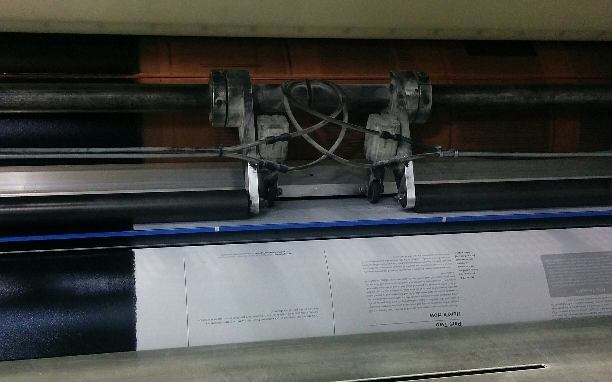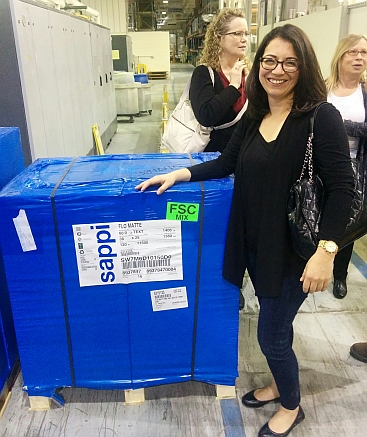Have you ever wondered how a book gets made? This month, several members of the Island Press team were lucky enough to tour one of our print vendors, Sheridan Books. They came back from the trip with pictures galore and a wealth of information about the print vendor’s side of the book making process. In order to share their experience, we will be posting a series of blog posts about the different stages of the book printing and binding processes.
At their Michigan facility, Sheridan has two types of offset presses, sheet-fed and web-fed, and one digital press, an HP Indigo Inkjet. They also have ink mixing, paper storage, cover lamination, case stamping, Smyth sewing, perfect binding, dust jacketing, and case binding capabilities at this facility. Sheridan’s print-on-demand facility is located in Pennsylvania, so the Island Press team was unable to see those processes first hand.
Offset Presses versus Digital Presses
There are several distinguishing characteristics between offset and digital print methods. The traditional, offset printing method uses thin aluminum plates and a rubbery blanket to transfer ink from the plate, to the blanket, and then finally to the paper. Digital presses print directly onto the paper using ink jets in a similar way that your desktop printer works, but on a much larger scale.

A signature is a publishing term for the sections of printed pages that are grouped together to form a book. Multiple pages are printed onto one oversized sheet. That sheet is then folded down several times and cut to make a signature. Signatures are always grouped in multiples of eight. Offset presses will print a single signature at a time; in contrast, digital presses print the whole book in order.

When printing offset, plates are changed for every signature while blankets will last for around two months. Because the blanket remains in place when the plate changes, there is a period of time called the “make ready” when paper goes through the press until the blanket has a clean copy of the new signature transferred onto it. The make-ready process is more efficient and environmentally friendly than changing the blanket for every signature.

Offset, Sheet-Fed Presses
Sheet-fed presses are distinguished from web presses primarily by the type of paper they use. Sheet-fed presses use paper that comes in pre-cut sheets while web presses use enormous rolls of paper. Most color printing is done on sheet-fed presses because the quality of the color is easier to control than on a web-fed press.
Sheridan has two sheet-fed presses on site. Both are 40-inch, eight-color presses. Eight-color means that the press can print 4-color on both sides of a single sheet of paper by only running it through the press once. When publishers talk about printing 4-color, they are talking about CMYK. CMYK stands for Cyan, Magenta, Yellow, and blacK. “K” is used for black instead of “b” because “b” is used for bold. These four colors are then used to build other colors, like green or purple, by layering different densities of the CMYK colors on top of each other. If you were to look at printed colors with a magnifying glass, you would see something like this. Each CMYK color has to have a separate plate created for it in order to layer the colors onto the paper in the correct order. You can see an example of what these plate might look like here.

The 40-inch press we saw at Sheridan had 8 towers, four for each side of the sheet of paper where the individual CMYK plates were loaded. Once the paper is inked, the towers also dry the ink then cool the paper so that the sheet is ready to go onto the next tower and the next color. At the end, a spray powder is used on the sheet so that the sheets don't stick together while waiting for the print run to be completed.
The pages are stacked on a pallet and sent to another machine for folding before it goes to the bindery.
Want to learn more about how books get made? Stay tuned for more in this series.


